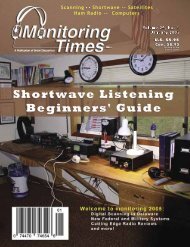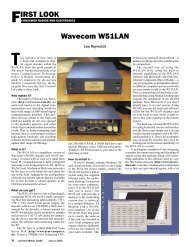RIGHT-click here - Monitoring Times
RIGHT-click here - Monitoring Times
RIGHT-click here - Monitoring Times
Create successful ePaper yourself
Turn your PDF publications into a flip-book with our unique Google optimized e-Paper software.
BELOW 500 kHz<br />
DXING THE BASEMENT BAND<br />
Kevin Carey, WB2QMY<br />
kevincarey@monitoringtimes.com<br />
Allure of Longwave<br />
Welcome to another edition of Below<br />
500 kHz. I’m often asked why I focus<br />
my work on the longwave band, and<br />
if I ever get tired of sifting through beacons. I<br />
know that I’m not alone in my pursuit, and this<br />
seems to be a good time to explore why we do<br />
what we do!<br />
First off, I’d like to say that longwave is not<br />
all I do, and that chasing beacons is not all I do<br />
when I am on longwave. I can be found exploring<br />
just about any band or mode below 148 MHz, and<br />
I even have a special affinity for a VHF band: 6<br />
meters. However, longwave does hold an intrigue<br />
that is hard to find elsew<strong>here</strong> in the radio spectrum,<br />
and I do spend much of my time t<strong>here</strong>.<br />
This month, we’ll review what draws many<br />
of us to longwave – in part to share the mystique<br />
to newcomers, but also to “jumpstart” veteran<br />
listeners on this amazing part of the spectrum.<br />
Here are the best reasons I can think of to include<br />
longwave in your listening menu…<br />
❖ New Ham Band Coming<br />
Sometime in 2013, we expect formal approval<br />
of a U.S. ham band from 472-479 kHz, resulting<br />
from recent WRC-12 proceedings. This band was<br />
a long time in coming, and now is an excellent<br />
time to learn more about longwave propagation<br />
and behavior. When approval is granted, you’ll be<br />
in a better position to take advantage of the new<br />
signals on the band, whether you are a ham or a<br />
DX-chasing listener.<br />
❖ Variety of Signals<br />
I’ve said it before and I’ll say it again: W<strong>here</strong><br />
else in the radio spectrum can you hear so many<br />
different types of signals in the space of just<br />
500 kHz? On longwave, you can expect to hear<br />
Natural Radio, Military signals, Time Stations,<br />
Broadcasters, Beacons, and Experimenters – all<br />
in this relatively narrow slice of spectrum. You<br />
simply cannot become bored!<br />
❖ Beacons: The Ideal DX<br />
Target<br />
If you were to design the perfect DX station<br />
to listen for, what features would it have? How<br />
about these for starters: 24-hour year-round operation,<br />
near omni-directional transmission pattern,<br />
constant and repetitive IDs (in CW mode, to help<br />
cut through noise), and published location/operator<br />
data. Guess what? Longwave beacons have<br />
all of these traits, making them a perfect DXing<br />
target.<br />
❖ Propagation Stability<br />
Take a listen sometime below 100 kHz,<br />
and what do you hear? For the most part, this<br />
is the land of military RTTY, time stations, and<br />
other utilities that use longwave for its reliability<br />
around the clock. How else would I hear Jim<br />
Creek, WA (NLK/24.8 kHz) in broad daylight<br />
near Rochester, NY, and hear the same station<br />
at night with virtually the same signal strength?<br />
When the signal positively must get through,<br />
day or night, longwave rules. Even higher up<br />
the band, stable propagation is a hallmark of<br />
longwave operation, although skip does begin<br />
to play a significant role above 100 kHz.<br />
❖ Not Everyone Can<br />
Tune It<br />
Getting on longwave used to be quite a<br />
challenge, because not many receivers available<br />
to U.S. listeners covered the band. Until<br />
the mid-1980s, you generally had two choices:<br />
Buy surplus military gear, or build up an outboard<br />
receive converter that would “move” the<br />
longwave band to a range your receiver could<br />
tune. Today, things are easier with the advent<br />
of wide-range receivers covering down to at<br />
least 100 kHz. Still, longwave capability is by<br />
no means universal, and a suitable antenna is<br />
required if you expect to hear much.<br />
❖ Historical Significance<br />
Some of the earliest work in radio communications<br />
took place on longwave. In fact,<br />
at one time it was believed that the longer the<br />
wavelength the longer the communication range.<br />
The shortwaves soon took over for most long<br />
haul work, but the unique behavior of longwave<br />
still makes it ideal for radio navigation, military<br />
and other specialized users. In fact, it is being<br />
“rediscovered” today as a fertile ground for low<br />
power experimentation and homebrew construction.<br />
❖ Underdog Status<br />
To borrow a theme from a well-known<br />
country song, some of us were “longwave” before<br />
longwave was cool. As one example, I recall<br />
former MT columnist Uncle Skip telling me of a<br />
chance encounter he had with an old timer who<br />
was chasing beacons on LF long before it was<br />
a popular pursuit.<br />
As I recall the story, Skip had stopped to<br />
check out some discarded electronic “junque”<br />
at the curb in front of this fellow’s house. As<br />
he sifted through the goodies, he could hear the<br />
repetitive sounds of Morse Code coming from<br />
inside the home. He introduced himself to the<br />
occupant and was invited inside to see the shack.<br />
T<strong>here</strong>, he noticed lists and lists of beacons this<br />
fellow had heard. Apparently, he pursued the<br />
activity with little or no knowledge that others<br />
chased beacons on a regular basis. He was just<br />
doing it to satisfy his own curiosity about these<br />
stations.<br />
That’s the kind of spirit I see even today<br />
in longwave, regardless of the particular area<br />
of interest. The “basement band” may not be for<br />
everyone, but it has a fiercely loyal following<br />
among those looking to explore the unusual and<br />
the intriguing!<br />
❖ Forgiving Circuitry<br />
It is well known that things get trickier,<br />
from a design standpoint, the higher you go in<br />
frequency. In microwave, for example, even the<br />
length of a trace on a circuit board can drastically<br />
affect the operation of a circuit. No such<br />
formalities exist in longwave radio. Component<br />
leads can be feet long and still work just fine.<br />
Audio transistors are sometimes used for RF<br />
applications, and breadboard or perfboard construction<br />
is perfectly acceptable. Does surface<br />
mount construction have you down? Plug in your<br />
soldering iron and try longwave!<br />
❖ Mailbag & Loggings<br />
I was pleased to hear recently from Larry<br />
Shaunce, WDØAKX (MN), who writes: “Saw<br />
your mention of the Sony 2010 as being a trusty<br />
radio and I have to agree with you – it is one great<br />
radio. Very reliable and the performance is just<br />
hard to beat. I must admit, I have not tried any<br />
of the more modern portable radios, but I use<br />
my 2010 on a daily basis and it has passed the<br />
test of time and still works like new. If anyone<br />
is looking for a used radio and can find one of<br />
these at a reasonable cost, don’t pass it up!<br />
“I use it when I am out of the shack in other<br />
rooms or outside under the shade tree on a sunny<br />
Sunday afternoon. It also sits by the bed at night<br />
for some late night tuning before I get to sleep,<br />
and the timer on it works great for this use, as I<br />
can fall asleep listening to something and it will<br />
shut down automatically after 1 hour, usually<br />
about right for it to soothe me to sleep.”<br />
Hello Larry, and thanks for writing to Below<br />
500 kHz. About the only trouble I’ve ever had<br />
with my Sony 2010 was with the battery contacts<br />
coming loose and giving me an error code on<br />
60 MONITORING TIMES August 2012
















